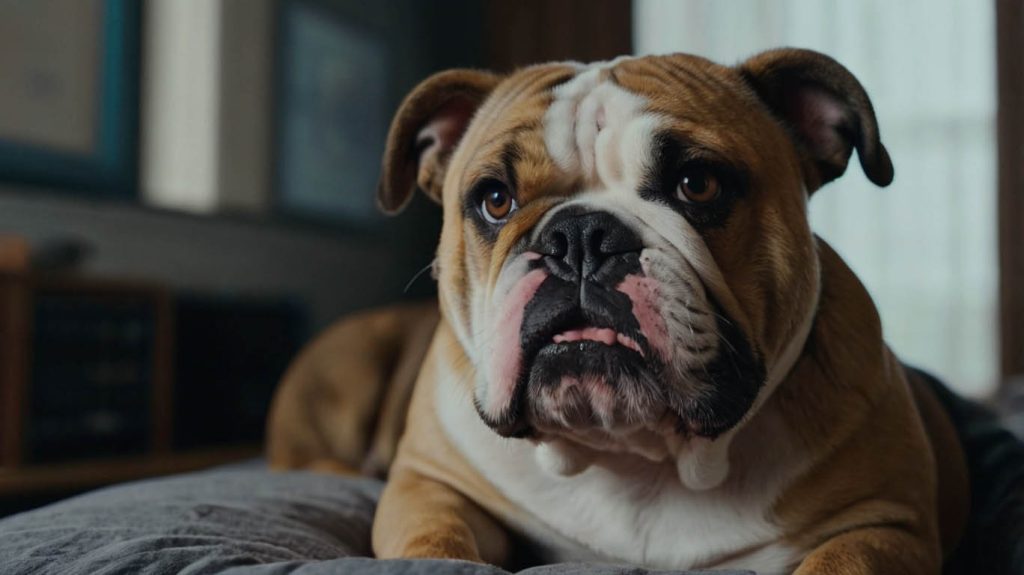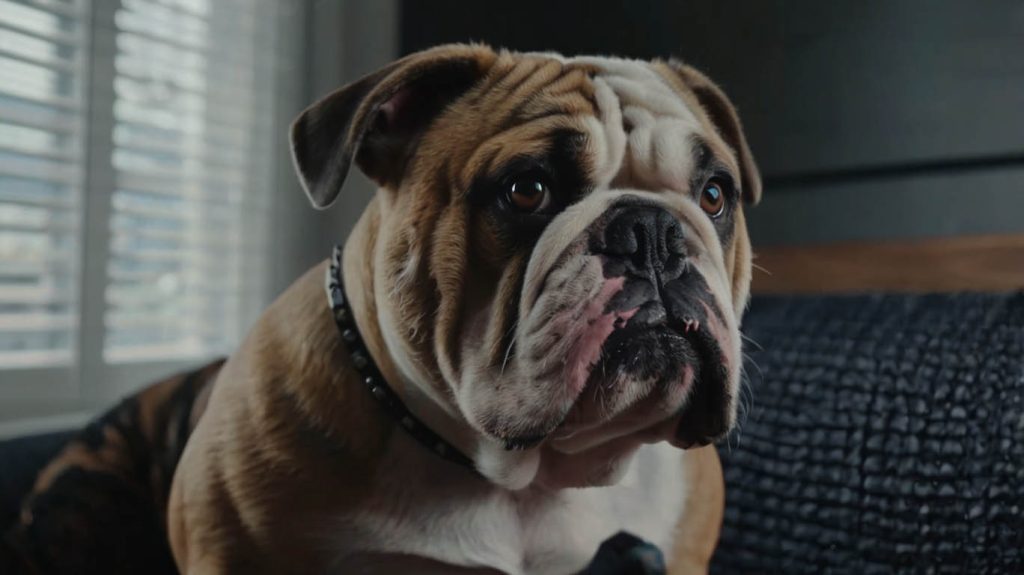Bulldogs are known for their wrinkly faces, loving temperament, and couch-potato nature. Yet, despite their tough exterior, they’re surprisingly sensitive inside. If your bulldog whines when you leave, chews on furniture when alone, or trembles during storms, these behaviors could be signs of something deeper—classic bulldog anxiety symptoms.
While it might seem like quirky behavior at first, recognizing anxiety early helps prevent serious behavioral and health issues. So, let’s dive into a story that shows just how overlooked these symptoms can be—and why your bulldog might just need a little extra emotional support.
Story: Bruno’s Whining Wasn’t Just Annoying—It Was Anxiety
Bruno, a 4-year-old English Bulldog, was adopted by Alex after his previous owner moved overseas. At first, Bruno was calm. But soon after settling in, he began whining when Alex left for work, pacing around the door, and chewing on couch cushions.
Thinking it was a phase, Alex ignored the signs. But Bruno’s behavior escalated—he started panting at night and avoided eating during storms. After a vet visit and some research, Alex learned these were common bulldog anxiety symptoms. With daily structure, a cozy crate setup, and help from a trainer, Bruno found peace—and Alex gained a deeper understanding of his companion’s needs.
This story reminds us that bulldogs may be stoic, but they still feel deeply.

Why Bulldog Anxiety Symptoms Shouldn’t Be Ignored
Anxiety isn’t just a temporary phase—it’s an emotional state that, if left unaddressed, can impact your bulldog’s quality of life. It can also strain your relationship and make basic care routines harder.
Consequences of Untreated Bulldog Anxiety Symptoms
- Leads to destructive behavior and house soiling
- Contributes to aggression or defensiveness
- Interferes with appetite and digestion
- Damages trust between you and your dog
- Elevates stress hormones that impact physical health
Spotting and responding to these symptoms early makes training easier and your dog’s life more joyful.
Common Bulldog Anxiety Symptoms You Need to Know
Bulldogs may not always wear their emotions on their sleeve, but their behavior offers clues. Here are the most common bulldog anxiety symptoms.
Excessive Whining or Barking
While bulldogs aren’t particularly vocal, sudden or persistent whining—especially when alone—is a strong indicator of anxiety.
Tip:
Record your dog’s behavior when you leave the house. Separation-induced vocalization is often missed until neighbors complain.
Destructive Chewing or Scratching
If your bulldog tears up furniture, doors, or bedding, it’s more than boredom. Anxiety often manifests through physical expression.
Tip:
Give your dog an alternative like a puzzle toy or frozen Kong to redirect anxious energy.
Pacing and Restlessness
Though bulldogs are usually relaxed, anxious ones will pace in circles or move from room to room without settling.
Tip:
Check for triggers such as thunder, visitors, or unfamiliar scents that may be causing stress.
Panting and Drooling Without Heat
If your bulldog is panting heavily without exercise or hot weather, anxiety may be the cause—especially when paired with drooling.
Tip:
Create a calm environment and monitor when panting begins. Use calming aids if needed.
Hiding or Clingy Behavior
Some bulldogs retreat to tight spaces when scared. Others do the opposite and become overly attached, refusing to leave your side.
Tip:
Respect their boundaries. Provide a quiet, familiar space with their favorite toys and bedding.
House Soiling Despite Training
Anxious bulldogs might urinate indoors, even if fully potty trained. This happens often during stressful events.
Tip:
Avoid punishment. Instead, re-establish a routine and reduce environmental stressors.
Why Bulldogs Are Prone to Anxiety
Although bulldogs are known for being mellow, they’re also highly loyal and can become emotionally dependent on their humans. Understanding the why behind bulldog anxiety symptoms helps you treat the root, not just the result.
Primary Causes of Anxiety in Bulldogs
- Separation from owners or changes in routine
- Past trauma or rehoming
- Lack of socialization as puppies
- Loud sounds such as fireworks or thunder
- Medical issues like pain or discomfort
- Overstimulation in unfamiliar settings
Once you identify the cause, you can address anxiety more effectively and compassionately.

How to Calm Bulldog Anxiety Symptoms Naturally
Addressing anxiety isn’t a one-size-fits-all fix—but there are several strategies that work well, especially for sensitive breeds like bulldogs.
Establish a Reliable Daily Routine
Bulldogs feel safer when they know what to expect. Feed, walk, train, and rest at the same times each day.
- Morning: Short walk, breakfast, play
- Afternoon: Nap, enrichment toys
- Evening: Calm activities like cuddling or brushing
Consistency brings security.
Practice Calm Socialization
Gradually introduce your bulldog to new people, dogs, and places.
- Start small (one person or dog at a time)
- Use treats and praise generously
- Retreat if signs of anxiety appear—try again later
Use Calming Products for Support
In conjunction with behavioral training, calming tools can help bulldogs cope better.
- Thundershirts or anxiety wraps
- Pheromone sprays (Adaptil)
- Calming treats with natural ingredients
- Soothing background music or white noise
Always use vet-approved products to avoid complications.
Try Crate Training or Safe-Zone Setup
Many bulldogs feel secure in enclosed spaces. Create a calming retreat where your dog can relax undisturbed.
- Include soft bedding and favorite toys
- Avoid using the crate for punishment
- Leave the door open during quiet times to encourage free use
Positive Reinforcement and Counterconditioning
Reward calm behavior with treats and affection. Help your bulldog form new, positive associations with previous triggers.
- Play storm sounds at low volume while giving a chew
- Reward staying calm during brief absences
- Use clicker training to shape confidence-building behaviors
Real Case Study: Lola’s Road to Calm
Lola, a French Bulldog, would cry and bark every time her owner left—even for five minutes. She chewed shoes and scratched doors relentlessly.
Her owner consulted a behaviorist and implemented daily crate training, short solo drills, and calming sprays. Within a month, Lola began tolerating 30-minute absences without whining. Today, she naps peacefully when left alone, even during noisy thunderstorms.
Lola’s journey proves that understanding bulldog anxiety symptoms leads to successful, long-term results.
FAQs About Bulldog Anxiety Symptoms
Are bulldogs prone to anxiety?
Yes. While calm in nature, bulldogs form strong attachments and can develop anxiety if left alone often or poorly socialized.
How can I tell if it’s anxiety or boredom?
Boredom leads to mischief, while anxiety includes whining, pacing, drooling, or fear-based reactions during specific events or routines.
Can I leave a bulldog home alone?
Yes—but only after gradual desensitization. Begin with short absences and use positive reinforcement.
Do bulldogs need medication for anxiety?
Only in severe cases. Many symptoms improve with behavioral strategies and calming tools. Consult your vet first.
What’s the most effective way to calm an anxious bulldog?
Consistency in routine, slow exposure to triggers, and positive reinforcement are the most reliable methods.
Conclusion: Don’t Dismiss Bulldog Anxiety Symptoms
Beneath that grumpy expression and solid frame lies a heart that feels deeply. If your bulldog is whining, pacing, or showing any other bulldog anxiety symptoms, it’s time to listen. These signals aren’t “bad behavior”—they’re cries for support.
With the right tools, structure, and empathy, you can help your bulldog feel safe, confident, and calm—no matter what the world throws their way.


